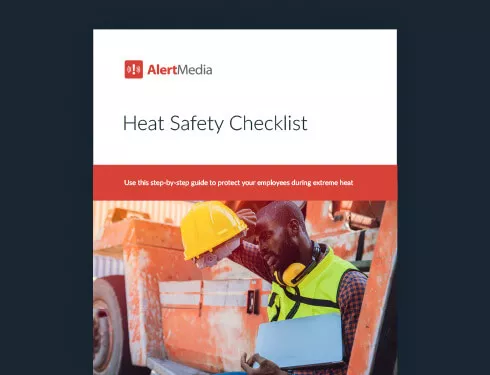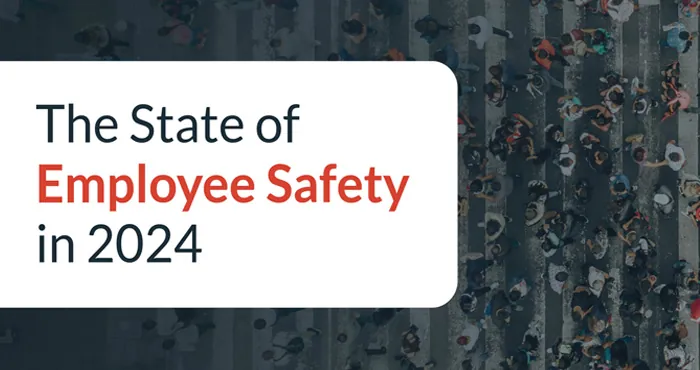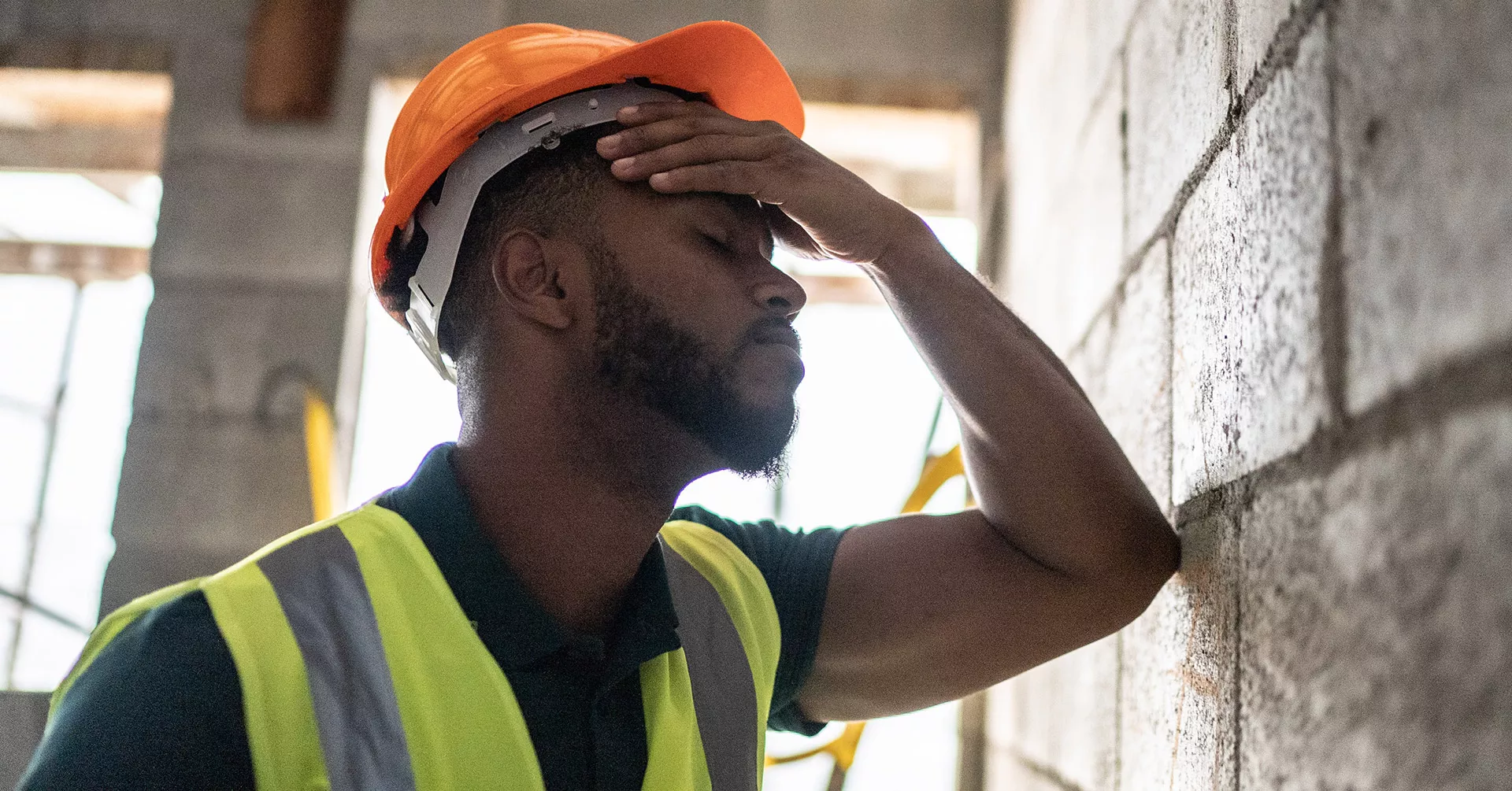
5 Heat Safety Tips for Workplace Compliance & Employee Health
High heat can pose a severe danger to your employees, but with careful planning, you can protect them from heat injury while keeping your business moving.

High temperatures have wreaked havoc across the globe in the last two years. 2023 was the hottest on record, and 2024 already sees extreme temperatures and record-setting heat waves. These heat events are not only miserable—they are also dangerous, killing thousands of people. “The 30-year average actually shows that we lose more people to heat than any other sort of weather event,” explains Paul Yura, Warning Coordination Meteorologist at the National Weather Service, in an interview on The Employee Safety Podcast. These extreme heat events will become more frequent and more deadly in the future due to human-caused climate change shifts in weather patterns.
What is a company to do in the face of these dangerous conditions? What’s expected of them, and, more importantly, how can they protect their people and operations? Here, we’ll discuss tips for working in the heat to keep your people safe and your organization chugging along despite the adverse conditions.
Heat Safety Checklist

5 Heat Safety Tips to Protect Workers
1. Provide adequate hydration
As internal body temperature rises, the body tries to keep itself cool, and sweating is the primary way it does so. By releasing water through our skin, evaporation of that water into the ambient air also has the side effect of taking some unwanted body heat with it. However, sweating can easily lead to dehydration, a dangerous condition that can cause seizures, shock, brain swelling, and even death. The only way to prevent dehydration in sweaty conditions is to ensure workers drink plenty of water and electrolytes to replenish what’s lost in sweat.
Most people would consider this a no-brainer, but it’s essential to prioritize it, especially when providing enough water to drink can be difficult or inconvenient. Indoor environments and other places with running water make it easy to provide a continuous source of cool water to workers, and water fountains or coolers should be installed if they aren’t already.
Some work environments, however, make providing water not so simple. Construction crews, roofing workers, utility workers, and others working in places without clean running water nave easy access to sufficient drinking water. Plastic coolers are portable ways to dispense drinking water and sports drinks to entire crews and can hold many gallons of liquid to keep workers hydrated throughout the day. Ensure that if you use this solution, you have enough coolers for your entire job site, and they are filled and refilled when running low. OSHA recommends that each worker drinks one pint of water per hour.
Pro Tip: Check out our post on OSHA heat regulations to ensure you’re in compliance.
2. Cool down your worksite and workers
Some workers are lucky enough to count on a comfortable work environment day in and day out, but for many, it’s an unavailable luxury. Employees doing outdoor work in warehouses, mines, and other exposed environments are at the mercy of the elements. That is unless their employers protect their health and safety from such hazards.
While it’s impossible to eliminate the sun’s heat from many worksites, there are accessible ways to minimize the discomfort and danger. These include:
- Setting up shaded or air-conditioned areas out of the direct sun for rest periods
- Issuing loose-fitting clothing and light-colored clothing
- Using fans to increase air movement
- Installing tinted windows and reflective exterior surfaces
- Providing sunscreen and UV-blocking clothing to avoid sunburn
The cooling modes available to organizations will vary depending on the nature of the jobs and locations, so be sure to consider your unique circumstances when setting up for work.
It’s also essential to consider other variables like humidity, sun exposure, and temperature. When calculating the temperature your employees are working in, use a Wet Bulb temperature measurement, which is a much more accurate indicator of how well your employees will be able to cool off.
Why protecting workers from heat stress matters
The effects of heat on human bodies can vary among people and episodes, but all workers and supervisors must know the potential dangers and how to spot them. If left untreated, high body temperature can cause heat illnesses, including heat stroke, heat rash, and heat cramps. It can also reduce one’s ability to function and can result in fatigue, dizziness, muscle spasms, and even brain damage and death. Check out our Heat Safety Checklist for more signs of heat-related illness and ways to respond.

3. Create a heat safety plan
The dangers that come with working in hot climates may be severe, but they are also generally predictable. Just as you would create a risk management plan for other disruptive events, like a natural disaster, you can also plan for heat exposure.
The exact plan you devise will be specific to your business, location, and type of work, but there are some commonalities. Here are the things you should consider including in your workplace heat safety plan:
- Designate a “heat safety officer” who provides daily oversight during hot working conditions
- Assess worksite hazards that might contribute to heat danger
- Develop a heat safety training curriculum
- Create work schedules that distribute hot-weather work among multiple employees
- Allow for adequate cooling breaks
- Devise a method for measuring heat stress among employees
- Plot out what you will do in the case of a National Weather Service heat advisory
- Use the NIOSH heat safety app (or similar tool) to determine the heat risk of the job site
- Create a response plan in case someone needs medical attention
Once you have a plan and can see it in action, it’s critical to continuously reflect on and improve upon it. After each heat safety incident, the heat safety officer and their colleagues should look back on what went well and what can be improved next time.
Planning for OSHA’s upcoming heat standard
While OSHA currently has no formal standard for heat safety, it’s closer than ever to being a reality. The administration recently released the unofficial language of the regulations for the public to read and respond to. You can learn more about the upcoming OSHA heat requirements here.
4. Look out for one another
Working in the heat is often so dangerous because the symptoms of heat exhaustion can sneak up on you quickly. Unless you always keep a thermometer on you, you can’t check your internal body temperature at will. That’s why it’s essential to look out for each other.
Heat stroke, one of the most common heat-related illnesses, causes confusion and a loss of consciousness, among other symptoms. By their nature, these symptoms are hard—or even impossible—to notice in yourself. That’s why implementing a “buddy system” can be crucial: it makes it much more likely that someone will see the signs of heat stroke in their work buddy. Workers on their own are much less likely to notice this in themselves due to the symptoms of heat stroke, such as impaired cognition and awareness. Training your employees on situational awareness can also help them spot signs of danger earlier before more severe symptoms kick in.
Train all of your workers in proper heat-related first aid procedures. If they notice a coworker suffering from heat illness, they should know how to care for them. Cooling heat-stroked workers down should be priority number one, and the fastest way to do so is with cold water or an ice bath. If that’s not available, move the worker to a cooler, shaded area and use wet towels to cool them down as much as possible while you call 911 for help.
You might also consider adding more workers to tasks that usually require fewer. The multiple advantages include increasing the number of people who can spot heat illness in their coworkers and spreading the physical stress of the work across more people, decreasing the chance that one person over-exerts themself.
5. Ease into strenuous work
Humans can adapt to just about any climate on Earth, but that doesn’t mean we can casually begin working during a sudden heat wave without ill effect. Instead, we must slowly start working in the heat to allow our bodies to adjust.
The CDC recommends giving workers one to two weeks to fully acclimate to excessive heat. On the first workday of a high-heat event, schedule workers to labor for only 20% of their usual workday. If a worker can perform well and safely on that day, then increase by another 20% to 40% of their regular workload the following day. Continue this trend until you reach the expected workload for your employees.
Acclimatization is integral to adjusting to hot-weather work, but it won’t be a uniform process for all your employees. Some people are more apt to adapt to hot climates quickly, and others aren’t. Workers with specific disabilities or low levels of physical fitness are more likely to have a more challenging time adjusting to hot environments.
Monitor employees closely for signs of heat illness during this period of acclimatization. If workers find it challenging to keep up with the gradual increase in work from day to day, allow them more time to adjust. Allow for frequent breaks in shade or air-conditioning. Even during acclimatization, people need occasional relief from the heat—do not deprioritize cooling rest breaks.
In short, make sure to individualize your approach to hot weather adjustment.
How to Implement Heat Safety Tips in the Workplace
As you evolve your heat safety procedures with the tips in this article, think about how they will fit into your overall safety strategies. These tips will be the most helpful when they are ingrained into the safety culture of your business and implemented consistently. Here’s how you can make the most of these heat safety recommendations.
Update workplace policies
Once you’ve identified a tip that applies to your employees or operations, it’s not enough to note it. Make it a functional part of your existing workplace safety policies. For example, if your safety code includes a section about proper working gear, be sure to include any new modifications related to heat, such as wearing UV-protective clothing that can keep workers cool. With all safety information organized together, you can manage regular policy updates and training effectively.
Train employees in heat precautions
Any changes to your safety procedures—including sections that manage the threat of hot weather—must be accompanied by timely training for the entire workforce. Just as you train employees to know how to handle a fire drill, a natural disaster, or a cybersecurity breach, you must conduct practical training sessions. Hence, all employees understand the dangers, warning signs, and action steps in heat exposure and heat stress cases. And as an employer, you must pay close attention to ensure that happens. As Paul Yura said:
Repeating training is critical to ensuring employees’ skills and knowledge stay fresh, especially during a scorching season. Therefore, it is recommended that heat safety training be included in the onboarding process for all new workers.
Solicit feedback and revisit policies.
Commit to continuous improvement once you’ve accounted for the dangers that hot weather can pose to your people and business. Regularly solicit feedback about policies and feelings of safety from employees who work in the heat. If they find current procedures and support sufficient, you’re on the right track—as long as you make updates when needed.
However, if employees say they find the policies unhelpful or cumbersome, it’s time to review procedures and employee engagement. When employees don’t understand or respect rules, they are more likely to ignore them—which, in the case of extreme heat, can lead to dangerous consequences. Prioritize changes to make your policies more effective and easier to follow.
Prioritize Employee Safety
No matter what environmental conditions your business contends with—be it inclement weather or other natural disasters—it’s imperative that you prioritize employee safety. Not only is it your duty of care and the morally right thing to do, but it will also ensure unexpected heatwaves don’t hamstring your operations. By using these tips for working in hot conditions, you’re protecting your people and your organization.




